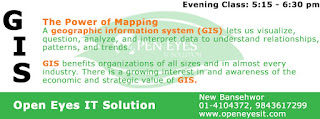 |
| GIS Training in Kathmandu Nepal |
GIS Training in Kathmandu Nepal @ Open Eyes IT Solution
Geographic Information System (GIS) deals with the analysis and management of geographic information. This course offers an introduction to methods of managing and processing geographic information. Emphasis will be placed on the nature of geographic information, data models and structures for geographic information, geographic data input, data manipulation and data storage, spatial analytic and modeling techniques, and error analysis. The course is made of two components: lectures and labs. In the lectures, the conceptual elements of the above topics will be discussed. The labs are designed in such a way that students will gain first-hand experience in data input, data management, data analyses, and result presentation in a geographical information system. Students must be clear that this is not a class specifically on any particular GIS software. It is a course on the underlying theory and concepts in GIS. The understanding of these concepts and theories will help you to perform spatial analysis in a GIS system properly and efficiently
Organizations use ArcGIS Online to facilitate collaboration and efficient access to maps and other GIS resources. This course shows how to publish data and map layers directly to ArcGIS Online as services, then use those services to quickly build a web map. You will also learn how to turn a web map into a web app to provide a focused experience for your audience. Access to an ArcGIS Online organizational account is needed to complete course exercises.
 |
| GIS Training in Kathmandu Nepal |
I.Introducing GIS
What is GIS
What GIS can do
Types of GIS projects
Remote sensing, GPS, SDSS
II.ArcGIS
Exploring ArcGIS
Spatial Data
Metadata
ArcCatalog
ArcToolbox
 |
| GIS Training in Kathmandu Nepal |
III. Working with ArcMap
Map documents
Windows and Menus
Help system GIS 111: August 2013
Data frames
Layers
Symbols and styles
Map scales and labeling
IV.Coordinate Systems and Map Projection s
Map projections and GIS
Coordinate Systems
Spheroids and datums
Common projection systems
Projecting data
 |
| GIS Training in Kathmandu Nepal |
V.Drawing and Symbolizing Features
Types of maps
Classifying numeric data
Using map layers
Editing symbols and using styles
Displaying rasters
VI.Working with Tables
Tables
Joining tables
Statistics
Summarizing tables
Editing and calculating tables
 |
| GIS Training in Kathmandu Nepal |
VII. Queries
What are queries?
Selecting
Using queries in GIS analysis
VIII. Spatial Joins
Spatial join
Types of joins
Setting up a spatial join
IX.Map Overlay
Map overlay
Other spatial analysis functions
Coordinate systems and map units
 |
| GIS Training in Kathmandu Nepal |
X.Presenting Data
Maps and Reports in ArcGIS
Working with map elements
Layout toolbar
Working with map scales
Setting up scale bars
XI.Geocoding
Introduction to geocoding
Geocoding styles
Geocoding process
Setting up the address locater GIS 111: August 2013
Reference data
x-y coordinates
XII. Basic Editing in ArcMap
Editing overview
The Editor Toolbar
Snapping features
Creating adjacent polygons
Editing features
Editing attributes
Saving work
 |
| GIS Training in Kathmandu Nepal |
XIII. Advanced Editing
Using sketch tools
Changing existing features
Combining features
Buffering features
Topology and shared features
XIV. Working with Geodatabases
About geodatabases
Creating geodatabases
Creating feature datasets
Using default values
Setting up domains
Split and merge
Subtypes
No comments:
Post a Comment